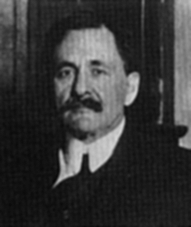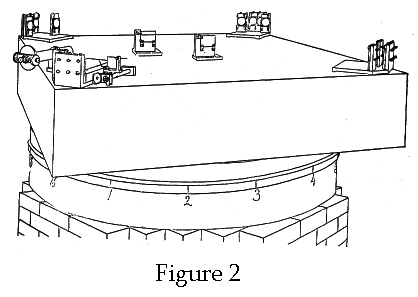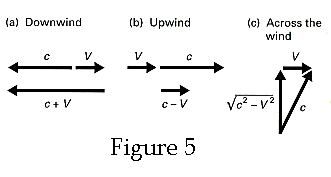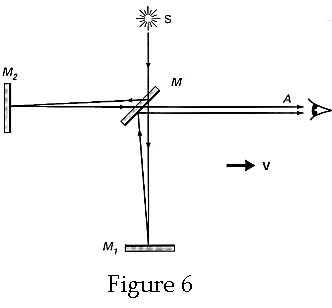
Michelson-Morely Experiment
Back
to Physics World
Back
to Special Relativity

Albert
Abraham Michelson (1852-1931)
American
experimental physicist, professor at Case University and at the University of
Chicago. He made precise measurements of the speed of light and interferometric
methods to determine the wavelength of spectral lines in terms of the standard
meter
The Ether
The ether
is a hypothetical medium that served as the carrier of light waves in the later
part of the 19th century and a few years of the 20th
century. In earlier centuries the word ether was used to designate a
ghostly substance that was believed to fill the upper regions of the universe
beyond the orbit of the Moon. It is believed that Descartes (1596-1650)
introduced into science the idea of a space-filling material (the ether),
a transmitter of otherwise incomprehensible actions. The idea of an ether was
employed by physicist studying electrodynamics as that medium in which light
moves. It was believed that light moved relative to the ether and if you changed
your frame of reference to a frame that is moving relative to the ether frame
then the speed of light would take on a different value. The first to attempt to
detect this motion was Albert Abraham Michelson in 1881. The experiment was
repeated with increased accuracy in collaboration with Edward W. Morely in 1887.
Michelson won the Nobel Prize in 1907 for this work.
Michelson
and Morely used an interferometer in an attempt to measure the speed of light
relative to the ether. A schematic
diagram appeared in the article Relative Motion of the Earth and The
Luminiferous Ether, by Albert A. Michelson and Edward W. Morely, American
Journal of Science, Nov. 1887. That diagram is shown below in Figure 1

The
sketches drawn of the actual interferometer are shown below in Figures 2 and 3


Figure 3
on the right shows a cross-section of the interferometer, which consists of a
slab of concrete floating in a pool of mercury. This makes it easy to rotate the
stone platform on which the interferometer is built. Rotating the interferometer
in this experiment is crucial to the experiment itself. The beam paths of the
interferometer shown in Figure 2 are shown schematically from above in Figure 4
below

Theory of Operation
The
following schematic diagram is found in most discussions and derivations of the
equation that is used to measure the phase difference of the two light beams.
One such diagram is shown below and it will be this diagram that we will use to
derive the phase relationship. In Figure 5 the velocity vectors for light
traveling to the left, to the right and across the ether wind, respectively are
shown.

In these
calculations it is assumed that the Galilean transformation is valid. That
transformation is used to derive the transformation relations of velocity. The
equation of interest here is
![]()
The
following derivations are derived using velocities as measured in the frame
moving to the right with respect to the ether with velocity V. The cross
wind component of the velocity of light, cy, is
given according to the above diagram, and thus has the velocity
![]()

Let the
to-and-from time parallel to the ether wind be T1
and the to-and-fro time across the ether wind be T2.
Then theses times are expected, within the ether model, to be
![]()

If the
wavelength of the light is l,
the phase difference between the emerging light beams is

Eq. (4)
can be simplified using the approximation (1 + d)n = 1 + nd. This gives

The
phase difference becomes
![]()
Thus,
the ether wind should cause a phase difference between the beams, and they will
interfere constructively and destructively. The appearance of the square of the
velocity makes this a second order effect. The phase difference can be
detected by rotating the entire interferometer by 90 degrees. During the
rotation, the phase difference should gradually decreases from the value in Eq.
(6) to its negative, and the interference of the beams alternates from
constructive, to destructive, to constructive, etc. These changes in the
interference thus serve as a sensitive test for the existence of an ether wind.
The Michelson and Morely failed to detect any ether wind whatsoever with their
interferometer.
Extinction
The
null results in the Michelson-Morely experiment were interpreted as evidence
that light does not require a medium, such as a luminiferous ether, to propagate
in. The constancy of light and the Principle of Relativity when combined lead to
the velocity transformation rules for special relativity. The above results were
derived by assuming that the interferometer is in a vacuum or that the results
will be independent of the presence of air. With this in mind I refer you to French
[2] who writes
In the particular case that one of the combining velocities-say ux’ – is equal to c and b1 – is equal to c, giving b2 = 1, then Eq. (5-4) yields the result ux = c for any value of v. This then includes the result that light emitted from a source that is moving relative to the laboratory still has the speed c, no matter how fast the source is moving.
As we mentioned in Chapter 3, this result, although an essential feature of Einstein’s formulation of relativity, did not receive a convincing demonstration until much later. One crucial reason is that propagation of light through a medium (even a transparent one) involves a continual process of absorption of the incident light and its reemission as secondary radiation by the medium – and it takes only a very small thickness of matter to bring about this replacement. Thus, for example, with visible light, a thickness of about 10-5 cm of glass or 0.1 mm of air at atmospheric pressure is enough to erase any possible memory, as it were, of the motion of the original source. This phenomenon, known as extinction (even tough it many not involve any appreciable loss of intensity in the light beam), has invalidated some of the observations (e.g. apparent motions of binary stars, already referred to in Chapter 3) that were at first believed to provide confirmation of Einstein’s second postulate – the invariance of c. We shall no describe two experiments which do not appear to be vitiated by the extinction phenomena. 1
The
“1” superscript refers to an article by J.G. Fox which is listed in the
references [3]. The phenomenon of extinction is almost always over looked in
textbooks that discuss the Michelson-Morely experiment. French’s text seems to
be the only one; or rather the only one I can find which mentions extinction.
References:
[1]
Relative Motion of the Earth and The Luminiferous Ether, by Albert A.
Michelson and Edward W. Morely, American Journal of Science, Nov. 1887
[2] Special Relativity, by A.P. French, MIT Press (1968), page
127-128.
[3] Evidence Against Emission Theories, J.G. Fox, Am. J. Phys.
33(1), January 1965